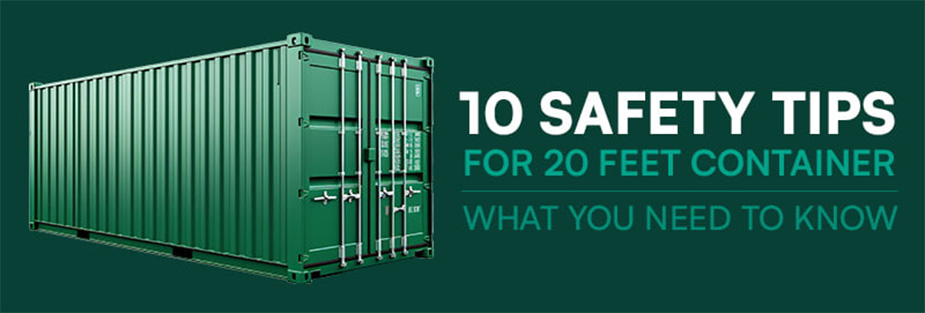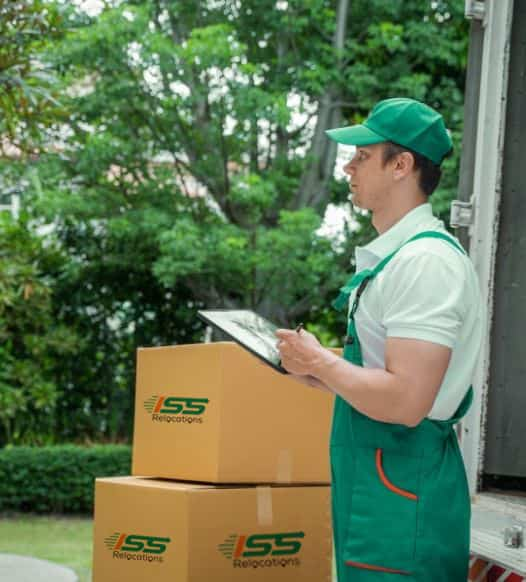
10 Safety Tips for 20 Feet Container: What You Need to Know
Welcome to ISS Relocations, your reliable partner in the difficult world of container logistics and relocation. As the world becomes more interconnected, the importance of efficient and secure goods movement grows. At ISS Relocations, we specialize in offering comprehensive container transfer solutions with a focus on the common 20 feet container.
In this digital environment, we hope to serve as a beacon of knowledge and advice, providing essential insights and expertise on the finer points of handling 20 feet container. Our dedication extends beyond facilitating flawless relocations to assuring the safety of your cargo and those involved in the loading process.
Secure Your Load Now
Prompts action to make sure the cargo is properly secured and distributed, referencing the blog’s weight-limit and lashing advice
10 Safety Tips for 20 Feet Container
The safety of your cargo and people while filling a 20 Feet Container is critical to a smooth and incident-free shipping experience. Here, we give ten critical safety advice that cover the subtleties of handling a 20 Feet Container, focusing on major factors such as container size, loading dynamics, and dimensions.
Follow Weight Limits
One of the foundational principles in ensuring the safety and integrity of cargo during the loading of a 20 feet container is adhering to specified weight limits. This practice is not only a legal requirement but also a critical safety measure that helps prevent accidents, structural damage to the container, and potential harm to individuals involved in the transportation process.
Understanding Weight Limits
Every 20 feet container comes with predefined weight limits, indicating the maximum allowable weight that the container can safely carry. These limits are calculated, taking into consideration factors such as the container’s structural capacity, the type of transportation used, and international shipping regulations.
Use Quality Packing Materials
In the realm of container logistics, the significance of utilizing high-quality packing materials cannot be overstated. This investment serves as a linchpin in ensuring the safe transit of goods within a 20 feet container. Particularly when it comes to fragile items, the choice of packing materials becomes a critical factor in safeguarding against the rigors of transportation.
Why Invest in High-Quality Packing Materials?
- Protection Against Impact: High-quality packing materials serve as an effective barrier against impacts and vibrations encountered throughout the voyage.
- Secure Encapsulation: Fragile products, such as glassware, electronics, or sensitive equipment, require appropriate padding and packaging.
- Optimal Space Utilization: Efficient packing materials enable optimal utilization of the container space.
Secure Heavy Items at the Bottom
When loading a container, careful item placement is critical to ensuring secure and sturdy cargo movement. One critical factor that has a considerable impact on the safety of the loading process is the practice of placing heavy goods at the bottom of the container and lighter items on top.
Maintaining Stability During Transport
The explanation for this technique stems from the need for a well-balanced and stable cargo layout. Placing heavier things at the bottom of the container results in a lower center of gravity, which reduces the possibility of imbalances during transportation. This strategic design improves the container’s overall stability, particularly when subjected to dynamic forces encountered during transit, such as rotations, accelerations, and decelerations
Call Us To Get Assured
Distribute Weight Evenly
Even weight distribution within a shipping container is a fundamental element that greatly contributes to cargo safety and stability while in transit. This approach entails deliberately positioning things to ensure that the load is evenly distributed throughout the container’s structure. The importance of accurately distributing weight cannot be emphasized, as it plays a critical role in reducing the danger of imbalances and accidents during transit.
Key Benefits of Even Weight Distribution
- Preventing Imbalances: One of the key benefits of spreading weight uniformly is that it prevents imbalances within the container.
- Enhancing Structural Integrity: Even weight distribution reduces stress on specific parts of the container’s structure.
- Reducing the Likelihood of Accidents: Containers with uneven weight distribution are more likely to tip or move when being handled or transported.
- Optimizing Space Utilization: The proper distribution of weight provides for the most efficient use of the container’s available space.
Secure Loose Items
In the complex world of container logistics, the significance of securing loose things within a container cannot be stressed. Loose materials can endanger not just the cargo’s integrity but also the safety of individuals involved in the loading and unloading processes. To reduce these hazards, it is critical to implement adequate steps to guarantee that all objects are properly attached to the containers.
Preventive Measures:
- Proper Packing: Begin by packing items securely within appropriate containers or boxes.
- Container Lashing or Strapping: Employing container lashing or strapping techniques is an effective means of securing loose items.
- Cushioning and Padding: For fragile items, provide additional cushioning and padding within the container.
- Strategic Placement: Carefully plan the arrangement of items within the container. Heavier items should be placed at the bottom, with lighter items on top.
Label Fragile Items
When shipping goods within a 20 feet container, one of the most important aspects is the proper treatment of fragile things. These delicate products, whether glassware, electronics, or other breakables, require additional care to avoid damage during loading and unloading. One excellent method for increasing the safety of fragile things is to mark them and put them strategically within the container properly.
Why Labelling Matters
Labeling delicate things acts as a visible reminder for handlers, reminding them to take extra precautions. Clear labeling serves as a communication tool during container loading and unloading, expressing the significance of tenderness and precision when handling specific commodities.
Utilize Container Lashing Enhancing Cargo Security: The Vital Role of Container Lashing Systems
In today’s fast-paced world of shipping and logistics, cargo safety is a major responsibility. Container lashing systems, which include crucial components such as straps and braces, act as silent guardians, ensuring that items stay securely in place throughout the journey. Let’s look at how these solutions add an extra degree of security, improving cargo integrity and shipping efficiency.
Consider Environmental Factors
In the complicated dance of global logistics, taking environmental issues into account is critical for assuring the safety and integrity of items being carried. The voyage from origin to destination frequently exposes goods to a variety of climatic variables, ranging from temperature swings to humidity variations. Here’s why and how you should consider these environmental variables when arranging container shipments.
Understanding the Impact of Environmental Conditions
Containers carrying a variety of commodities travel across oceans, through different climates, and various air conditions. Temperature, humidity, and other environmental factors can have a major impact on the quality and condition of the cargo inside. Goods that are susceptible to these elements require special care to maintain their integrity and avoid potential damage.
Train Personnel Properly Safeguarding Cargo through Knowledge and Expertise
In the complex world of container loading, the value of well-trained workers cannot be overemphasized. Adequately trained professionals not only help the loading process’s efficiency but also play an important role in guaranteeing the safety of both the cargo and the staff involved. Let’s look at why personnel training is so important for successful container loading operations.
Regular Maintenance Checks: Safeguarding Container Fitness for Transport
Regular maintenance checks on shipping containers are crucial to ensuring both the cargo’s safety and the container’s integrity. Containers can be damaged by long voyages, exposure to changing environmental conditions, and the wear and strain involved with transportation. Here’s why frequent maintenance checks are essential and how they contribute to the overall fitness of the container for shipment.
Conclusion
As we wrap up our exploration of the most important safety tips for handling 20 feet containers, it becomes clear that emphasizing safety is not just a choice but a requirement in the complex world of logistics. The 20 feet container, a staple of global trade, necessitates painstaking attention and adherence to best practices to ensure the safety of both cargo and staff involved in the loading process.
By following the 10 safety measures provided here, from adhering to weight limits to using container lashing and performing regular maintenance inspections, we can ensure safe and incident-free container trips. These standards serve as a guide for logistics professionals, ensuring that the loading procedure is both efficient and, more importantly, safe.
Plan Stress-free Move with Top Moving Company in UAE - ISS Relocations

Frequently Asked Questions
How much can we load in a 20ft container?
A standard 20 feet container can typically hold around 25-28 cubic meters of cargo. The exact load capacity depends on the type of goods being transported. ISS Relocations ensures efficient container loading to maximize space while following safety regulations.
How much weight can you put in a 20 ft container?
A 20 feet container has a maximum payload capacity of around 24,000 kg (52,900 lbs). However, actual loading capacity depends on transportation regulations in different countries. ISS Relocations provides professional container loading services to ensure safe and legal weight distribution.
How do you transport a 20 foot shipping container?
A 20 feet container can be transported using trucks, trains, or ships. It requires specialized handling equipment like forklifts or cranes for loading and unloading. ISS Relocations arranges secure transport solutions tailored to your needs, ensuring timely delivery.
What is the capacity of a 20 container?
A 20 feet container has a volume capacity of approximately 33 cubic meters, but actual usable space is around 25-28 cubic meters due to structural limitations. ISS Relocations optimizes packing techniques to maximize efficiency and prevent damage during transport.
How do you calculate container load?
Container load calculation involves measuring cargo dimensions, weight, and stacking ability to optimize space. Using load distribution software and proper palletization techniques ensures efficient use of capacity. ISS Relocations assists in proper container planning and loading.
How many pallets can load in a 20ft container?
A 20 feet container can fit approximately 10-11 standard pallets (120cm x 100cm) or around 9-10 Euro pallets (120cm x 80cm). ISS Relocations offers professional container loading services, ensuring secure and space-efficient packing for hassle-free shipping.
How many tons can a 20ft container carry?
A 20 feet container can carry approximately 24 metric tons (24,000 kg) of cargo. However, weight limits may vary based on road transport regulations. ISS Relocations offers expert guidance on proper weight distribution and safe container loading.
Moving Company - Recent Blog
Stay informed and prepared for your next move with our latest blogs on moving services in the UAE. From expert packing tips to international relocation guides, ISS Relocations brings you up-to-date insights to make your moving experience smoother, safer, and stress-free.










